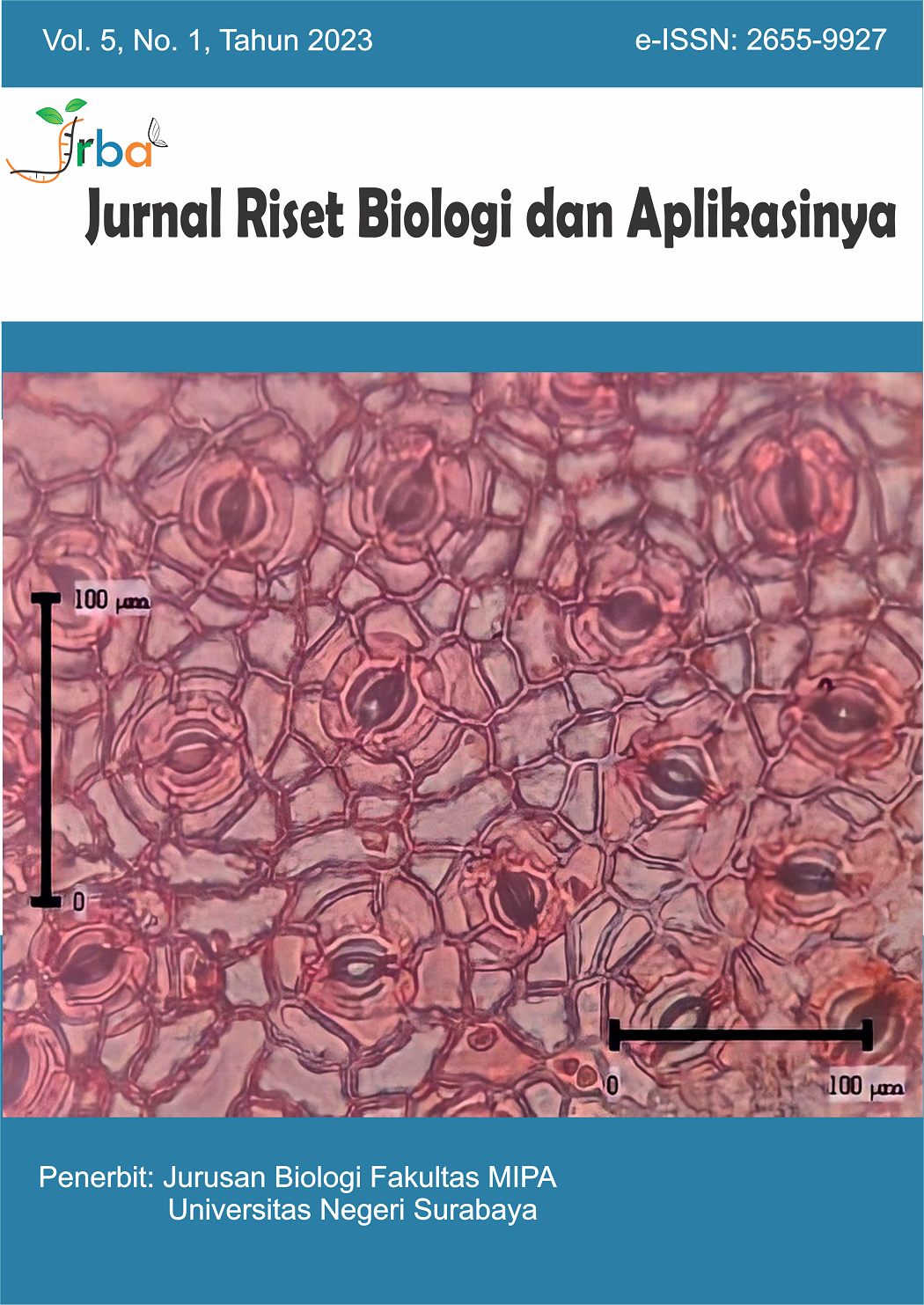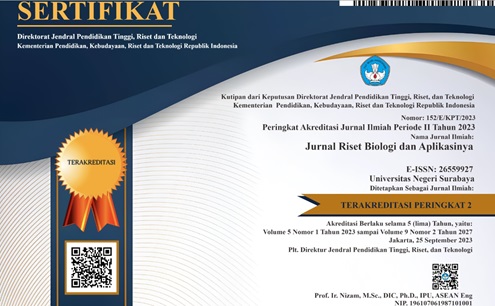Etlingera (Zingiberaceae) in Bogor Botanic Gardens: Potential Benefits and Its Conservation Status
DOI:
https://doi.org/10.26740/jrba.v5n1.p1-7Abstract
Indonesia is one of mega biodiverse countries in the world, with a high global biodiversity index and many vascular plant species. However, not all plant species are known in terms of their uses, potential benefits, and conservation status. One of example is genus Etlingera, where further studies are required. Therefore, this study aimed to provide information on the potential benefits and uses of the genus Etlingera and to investigate its conservation status. The study was conducted using the method of literature study, an inventory of potential uses, and an inventory of the genus Etlingera living in Bogor Botanic Gardens through direct observation. Six species of the genus Etlingera were collected from the Bogor Botanic Gardens, namely Etlingera brevilabrum, E. elatior, E. hemisphaerica, E. loerzingii, E. megalocheilos, and E. walang, conservation status of three species (E. brevilabrum, E. hemisphaerica, and E. megalocheilos) is Least Concern (LC), two species (E. elatior and E. walang) are Data Deficient (DD), and one species (E. loerzingii) is Vulnerable (VU). All species are commonly used as spices, condiments, cosmetics, and traditional medicine to cure various diseases, possibly also as ornamental plants. The secondary metabolites present in some species, namely E. brevilabrum, E. elatior, and E. hemisphaerica can be used as antimicrobial, antifungal, and antioxidant agents.
References
Ariati, S. R., Astuti, R. S., Supriyatna, I., Yuswandi, A. Y., Setiawan, A., Saftaningsih, D., & Pribadi, D. O. (2019). An Alphabetical List of Plant Species Cultivated in Bogor Botanic Garden. https://doi.org/10.14203/press.107.
Darajati, W., Pratiwi, S., Herwinda, E., Radiansyah, A. D., Nalang, V. S., Nooryanto, B., Rahajoe, J. S., Ubaidillah, R., Maryanto, I., Kurniawan, R., Prasetyo, T. A., Rahim, A., Jefferson, J., & Hakim, F. (2016). Indonesian Biodiversity Strategy and Action Plan 2015-2020. http://ksdae.menlhk.go.id/assets/publikasi/Buku_IBSAP%202015-2020.pdf.
GFW. (2023). Global Forest Watch. Available at: http://www.globalforestwatch.org/.
Ibrahim, H., & Setyowati, F.M. (2016). Etlingera (PROSEA). PlantUse English, 4 May 2016. Available at: https://uses.plantnet-project.org/e/index.php?title=Etlingera_(PROSEA)&oldid=222063. (Accessed: 7 October 2022).
Jansen, P. C. M. (2022). Etlingera walang. (PROSEA). Plant Resources of South-East Asia. Available at: http://uses.plantnet-project.org/en/Etlingera_walang_(PROSEA). (Accessed: 12 October 2022).
Mahdavi B., Yaacob W. A., Din L. B., & Aisha, M. A. S. 2013a. Essential Oil Composition of Three Air-Dried Parts of Etlingera brevilabrum. Journal of Essential Oil-Bearing Plants, 16(1), 17-22. https://doi.org/10.1080/0972060X.2013.764200.
Olander, S. B. (2019). Etlingera walang. The IUCN Red List of Threatened Species. https://doi.org/http://dx.doi.org/10.2305/IUCN.UK.2019-3.RLTS.T117325529A124282427.en.
Olander, S. B. (2020). Etlingera loerzingii. The IUCN Red List of Threatened Species. https://doi.org/https://dx.doi.org/10.2305/IUCN.UK.2020-2.RLTS.T117321028A124282197.en.
Poulsen AD. (2012). Etlingera of Sulawesi. Kota Kinabalu: Natural History Publications.
Poulsen, A. D., and Olander, S. B. (2019a). Etlingera elatior, Torch Ginger. The IUCN Red List of Threatened Species. https://doi.org/http://dx.doi.org/10.2305/IUCN.UK.2019-1.RLTS.T117234456A124279013.en.
Poulsen, A. D., & Olander, S. B. (2019b). Etlingera megalocheilos. The IUCN Red List of Threatened Species. https://doi.org/http://dx.doi.org/10.2305/IUCN.UK.2019-2.RLTS.T117321541A124282227.en.
Poulsen, A. D., Olander, S. B., & Docot, R. V. A. (2019). Etlingera brevilabrum. The IUCN Red List of Threatened Species. https://doi.org/http://dx.doi.org/10.2305/IUCN.UK.2019-2.RLTS.T117317653A124282017.en.
Rusanti, A., Sukandar, D., Rudiana, T., & Adawiah. (2017). Profil Fraksi Sitotoksik terhadap Sel Murine Leukemia P-388 dari Ekstrak Biji Honje (Etlingera elatior). Jurnal Kimia Valensi. 3(1). https://doi.org/10.15408/jkv.v0i0.3640.
Saw, L. G. (2019). Etlingera hemisphaerica, Black Tulip. The IUCN Red List of Threatened Species. https://doi.org/http://dx.doi.org/10.2305/IUCN.UK.2019-3.RLTS.T117319869A124282147.en.
Suryani N., Nurjanah D., Indriatmoko D. D. (2019). Aktivitas Antibakteri Ekstrak Batang Kecombrang (Etlingera elatior (Jack) R.M.Sm.) terhadap Bakteri Plak Gigi Streptococcus mutans. J. Kartika Kimia, 2(1), 23-29.
Tamokou J. D. D, Mbaveng A.T., and Kuete V. (2017). Antimicrobial Activities of African Medicinal Spices and Vegetables Therapeutic Potential against Metabolic, Inflammatory, Infectious and System Diseases. United Kingdom: Academic Press, Elsevier pp. 207-237.
WWF (World Wildlife Fund). (2019). Deforestation in Borneo and Sumatra. Available at: http://wwf.panda.org/our_work/forests/deforestation_fronts/deforestation_in_borneo_and_sumatra/.
Downloads
Published
How to Cite
Issue
Section
License
Copyright (c) 2023 Jurnal Riset Biologi dan Aplikasinya

This work is licensed under a Creative Commons Attribution-NonCommercial 4.0 International License.
 Abstract views: 1188
,
Abstract views: 1188
, PDF Downloads: 415
PDF Downloads: 415












